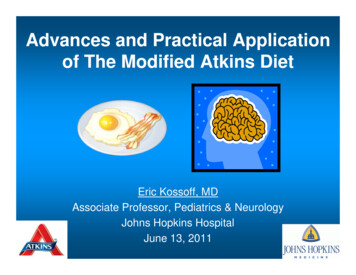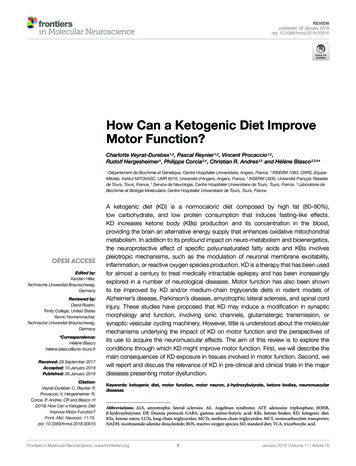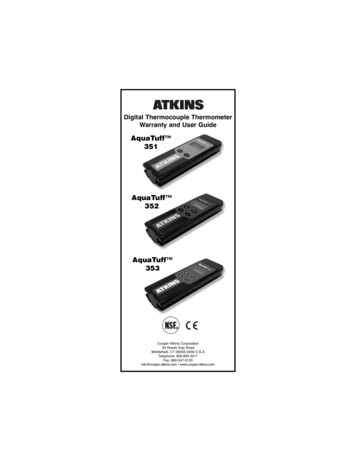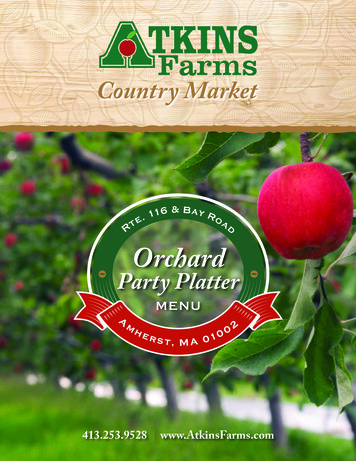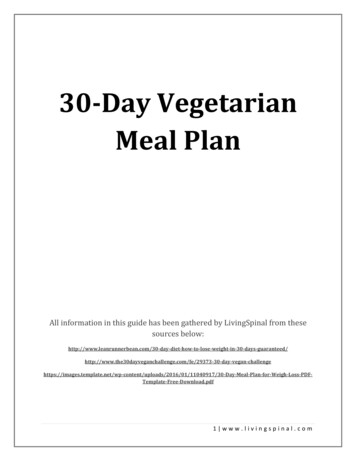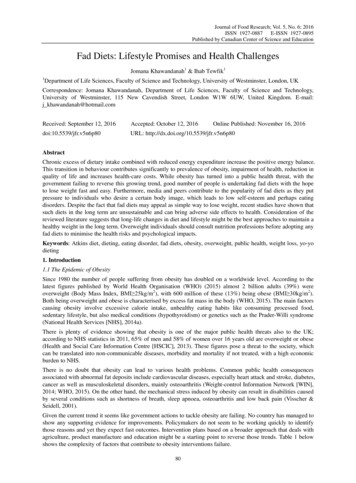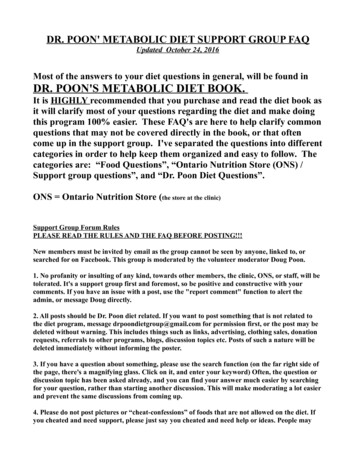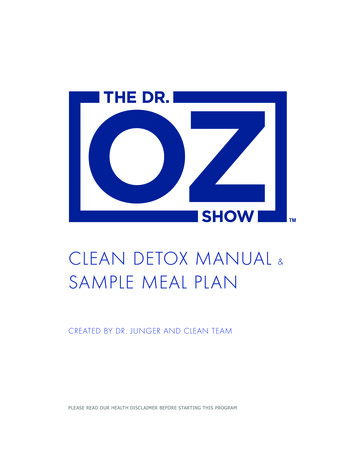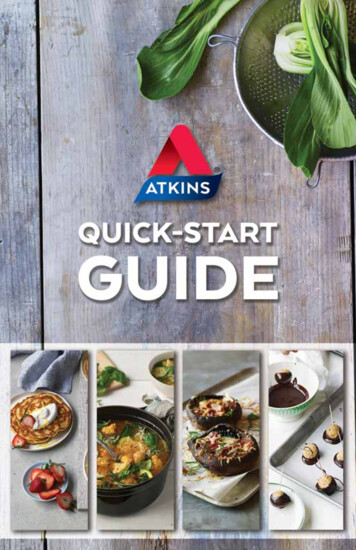
Transcription
The Modified Atkins Diet ManualAdult Epilepsy Diet CenterJohns Hopkins Adult Epilepsy Diet Center ManualPage 1
Welcome to the Modified Atkins Diet!By sticking to this diet, you have a good chance of reducing your current seizure activity. Sincethis is a new diet for you, please take the time to read through all the materials and ask manyquestions to ensure that you understand your new diet.The food that we eat and the liquid that we drink are made up of three basic ingredients:carbohydrates, fats (also called lipids) and protein. Different foods and drinks have differentamounts of carbohydrates, fats, and protein. Our body uses all of these nutrients for energy tobuild bones, to power your brain, to pump your blood and to live. However, our bodies use eachof these three differently.The Modified Atkins Diet is a diet that is very low in carbohydrates and very high in fat. You caneat some of the same foods you do now and even eat out at some of your favorite restaurants.In this information manual, everything you need to know to start, maintain, and enjoy the dietwill be explained, including: What are carbohydrates and fats? What foods are high and low in these nutrients? How to plan meals Where to turn for credible informationContact info for clinicians has been removed for publication.Thanks and good luck!Dr. Mackenzie CervenkaDr. Eric KossoffBobbie Henry, RD, LDNRebecca Fisher, RN, BSN, CNRNJoanne Barnett, Medical Office CoordinatorAdult Epilepsy Diet Center – August 20152
Modified Atkins Diet Summary Eat no more than 20 grams of net carbohydrates each day. Eat either 3 regular sized meals or 4 ‐ 5 smaller meals each day. Do not skip meals or go more than 6 waking hours without eating. Drink at least eight‐8 oz. glasses of water each day to hydrate your body and avoid side effects. Take a multivitamin and calcium with vitamin D supplement daily. Adjust the amount of food you eat to suite your appetite. Eat until you are satisfied. Eat multiple servings of fats with every meal—your food should SHINE!EAT LIBERAL COMBINATIONS OF FAT AND PROTEIN, BUT MOSTLY FAT!Fat Oils, Butter Mayonnaise Heavy/whipping cream AvocadoProtein Eggs Poultry Fish, Shellfish Red meatLIMIT THE AMOUNT OF HIGH CARBOHYDRATE FOODS. FruitBread, pasta, riceCrackers, cereals, grainsStarchy vegetables likepotatoes, corn, green peasDairy products (other thancheese, cream, or butter)WARNING—BE ON THE LOOKOUT! Don’t assume any food is low in carbohydrates. Read the Nutrition Facts food label.Do not trust products with labels such as—Sugarless, Sugar‐free, No Sugar Added. You must still read thecarbohydrate grams on the Nutrition Label.Watch out for Low Fat and Fat Free products which will most likely contain carbohydrates.Prepared salads, like coleslaw and tuna salad, are often made with sugar. Be careful at salad bars anddeli counters. It is best to make your own.Adult Epilepsy Diet Center – August 20153
Side Effects of the DietAre there potential side effects?All therapies have either side effects or potential side effects. You may feel sluggish for a few days after the dietis started. Other potential side effects may include nausea, vomiting, constipation and dehydration. These canbecome serious if not managed correctly. Kidney stones and high cholesterol have also been reported.How do I manage side effects?Dehydration: Ketosis decreases thirst as well as causes sedation; therefore fluid intake may be less than optimal.We encourage you to drink plenty of water and monitor for signs of dehydration such as weakness, dizziness,palpitations, confusion, dark colored urine, and fatigue. Call your doctor if you suspect you are experiencingdehydration.Vomiting: Excess ketosis and acidosis may result in vomiting. If vomiting is repeated, please contact the AdultEpilepsy Diet Center or call your doctor.Kidney Stones: Kidney stones are uncommon, but a potential side effect because of the high amount of fat. Astone may manifest as non‐specific illness, fever, poor appetite and abdominal pain. Kidney stones will notusually warrant a discontinuation of the diet. To reduce the risk of kidney stones, ensure that you get plenty ofwater throughout the day. Large kidney stones may require lithotripsy or even surgical removal.Constipation: A change in bowel habits is expected on the diet, which may or may not be consideredconstipation. The diet has less bulk than regular food, so you may have fewer bowel movements than beforestarting the diet. If constipation is a problem, there are a few things you can do. The most important way tomanage constipation is staying ahead of it with generous hydration. That means at least 8 large glasses of watera day! Some treatment options for mild constipation are daily stool softeners such as docusate sodium (Colace )or a laxative like Senokot . For more difficult constipation, some other treatment options are Milk of Magnesia,Miralax , unflavored Fleet Phosphosoda , and Fleet Enema. Talk to your doctor, Dr. Cervenka, or Bobbie Henryif you have problems with constipation. Adult Epilepsy Diet Center – August 20154
Beverage Choices to Stay Hydrated and Minimize Side EffectsStaying hydrated can help to minimize the side effects of MAD, so aim for about 8cups of water daily.There are many name brands and store brand flavored waters andpowder drink mixes available today. Some are artificially sweetened,some are unsweetened, and some are carbonated. Remember to readthe Nutrition Facts label for total carbohydrate content. Some may evenhave fiber. Subtract fiber grams appropriately.Make a large jug from no‐carb powdered mixes to refill your water bottle periodicallythroughout the day, or carry around individual packets to flavor water on the go.Some people find it helpful to keep track of how much they are drinking my settingup phone or desktop reminders. Other ways include drinking a small cup of water ateach hour of your work day, or a large cup of water every time you use the restroom. Examples:Brand names have been removed.Example 1Example 2Remember to drink more than usual if you are exercising, sweating, or in a dry climate. It may benecessary to use an electrolyte replacement beverage. Carb‐free and low carb varieties that are easy tofind include:Pictures of carb‐free and low carb varieties have been removed for publication.Adult Epilepsy Diet Center – August 20155
How to Read the Nutrition Facts Label – BACK of the packageWhat is the layout of the Nutrition Facts Food Label?Most food labels will look similar to the one below. The information on the top has the serving size and servingsper container. Then, the nutrients and amounts are listed. Amounts are per serving—not per container—unlessof course there is only one serving per container, as in a 1‐oz bag of chips or a small yogurt container. Below thenutrients there is a footnote section with the Daily Values (DVs) for 2000‐2500 calorie diets. This information isnot important to know on this diet.What should I look for on the food label?1. Total Carbohydrate! Remember you can have up to 20 grams net carbs for the whole day (unless otherwisespecified). Choose wisely.2. Dietary Fiber (if there is any): Fiber is a type of carbohydrate that is very important for health, but it does notget digested and metabolized the same way other carbs like sugar do. You may subtract the grams of fiberto get the “Net or available Carbs”. Look at the example below. Total Carbohydrate reads 6g and the DietaryFiber reads 2g. The net/available carbs would be 6g‐2g 4g. If soluble and insoluble fiber are listed underDietary Fiber, only subtract Dietary Fiber grams.3. Serving size: Pay extra attention to the serving size. If you have two servings, double the grams ofcarbohydrates (or net/available carbs, if there is fiber). If you eat this whole bag of veggies, that’s 16 gramsof carbs to count towards your 20.4. Sugar alcohols (e.g. maltitol, xylitol) — do not subtract sugar alcohols (unless it is erythritol). Be careful here!If the food label says it has 0 grams of carbohydrates, does that really mean ZERO?The Food and Drug Administration made rounding rules to be used when reporting the quantities of nutrients infoods. This applies to the Nutrition Facts labels and is used by food journalists and recipe writers who report thenutritional composition of their published recipes. Carbohydrate is rounded to the nearest 1 gram. If the itemhas less than 1 gram, it may be reported as “less than 1 gram". If the item has less than 0.5 gram, it will berounded to zero.Adult Epilepsy Diet Center – August 20156
Sugar Alcohols and FRONT of the Package LabelingThere are many “low carb” products in the marketplace. Be advised that these products may label the FRONT ofthe package with carbohydrates grams, called “Net Carbs” or “Impact Carbs”. This number is likely incorrectaccording to the MAD, because the way these manufacturers calculate and the way the MAD calculate net carbsis different. These manufacturers are subtracting the sugar alcohols grams from the total carbohydrate amount.This is very common in ready‐to‐eat snack bars, like the one shown below. On MAD, sugar alcohols are notsubtracted from the total carbohydrate content.Sugar alcohols are neither sugar, nor alcohol. They are aderived from sugar and are still considered a type ofPicture of an example of a low carbcarbohydrate. Sorbitol, mannitol, xylitol, maltitol, maltitolproduct with sugar alcohols.syrup, lactitol, and erythritols are some types of sugaralcohols. They are commonly used in the food industry insugar‐free, reduced‐sugar, and diabetic foods because theydo not contribute as many calories as sugar does. Yet, each sugar alcohol is different and some will contributejust 1 calorie fewer than sugar. It is suspected that people will metabolize and digest sugar alcohols differently.For this reason, while on the MAD, only subtract fiber from the total carbohydrate content.To get the correct number of carbohydrates, turn the package over and read the Nutrition Facts label for thetotal carbohydrate and fiber grams. Take the total carbs and subtract the amount of fiber only. This is thecorrect number of carbohydrates. In special situations, it is OK to subtract erythritol ONLY, as this has the leastimpact on the body.For more information about sugar alcohols, please visit the Sugar Alcohols Fact Sheet at www.foodinsight.org.What about foods without a food label?As you may have noticed, not all foods have a Nutrition Facts label. Foods without labels include most freshfruits and vegetables—the kind you bag yourself at the store. Frozen, canned, and fresh packaged produce docontain nutrition facts. During your first month on the diet, you may learn the carbohydrates in produce by usingfood lists (provided here) or by eating packaged produce that has the carbohydrate content already on the label.Keep in mind, packaged food may contain additional ingredients like preservatives, sauces, and/or flavoringsthat have carbohydrates. Always read the Nutrition Facts Label, if one is provided.How do I know how many carbohydrates are in fresh, unpackaged produce?The next few pages are quick reference sheets for the carbohydrate content of fruits and vegetables. Produce islisted alphabetically. You may also use one of the many websites that provide nutrition facts for foods. All youdo is type the food in the search bar, find the food you are looking for, and locate the serving size, and carb andfiber grams. Good websites are www.calorieking.com and www.fatsecret.com.Produce carb counting sheets have been removed for publication.Adult Epilepsy Diet Center – August 20157
How to Shop and Stock Your Pantry/Fridge/FreezerShop the perimeter of the grocery store forfresh fruits and vegetables, meats, fish,poultry, and low‐carb dairy products.More of your food items will be perishable—keep in refrigerator and freezer. You may findthat you have to shop more frequently.Plan ahead! Keep frozen meats andvegetables for quickmeals.Make meals in advance forthe week. You don’t haveto be creative and varymeals if you really like onelow‐carb recipe!Keep refrigerator full ofready‐to‐eat low‐carbveggies and fruits. See theproduce sheets in thismanual.Stock Your PantryGreat for power‐outages MayonnaiseHerbs and spicesCapersCanned VeggiesCanned seafood and chickenSugar‐free gelatin dessertSugar‐free jams and jelliesCanned green chiliesCoconut milkSun dried tomatoes in oilPestoDill PicklesLemon or lime juiceMacadamia nuts andalmonds“Natural” peanut butterAlmond butterAdult Epilepsy Diet Center – August 2015Be extra careful withthese pantry items asmany brands will havecarbohydrates. Read thenutrition facts label to findthe lowest carb versions. Broths/bouillonExtractsHorseradishHot saucesKetchupMustardMayonnaiseSalsasSoy sauce/tamariSalad dressingsVinegarsTomato sauceAlfredo sauce8
Your First Shopping ListPRODUCE avocados spinach leafy greens cucumber boston, bibb, butterhead lettuce celery cauliflower eggplant blueberries raspberries strawberriesCONDIMENTS bacon bits mayonnaise salad dressing tomato sauce horseradish sauerkraut hot sauce mustard capers pickles olives pestoDELI sliced lunch meat sliced cheesesFROZEN veggies and fruit fish fillets chicken wings meatballsMEAT bacon salami ground beef chicken wings chicken thighs breakfast sausage pepperoniDAIRYCANNED tuna in oil salmon chickenSNACKS pork rinds almonds, pecans, walnuts, macadamia nuts sour cream unsweetened almond milk unsweetened coconut or hempmilk sliced or block cheese mascarpone cheese eggs heavy whipping cream cream cheese sugar‐free Jello, prepared butterBAKING olive, canola oil coconut oil unsweetened coconut flakes baking chocolate unsweetened cocoa powder coconut flour almond flour Splenda, stevia, other artificial sweetener Plastic or glass to‐go storage containersAdult Epilepsy Diet Center – August 20159
Books Shown in ClinicKetogenic Diets: Treatments for Epilepsy and Other Disorders. Written by Eric H.Kossoff, M.D., John Freeman, Zahava Turner, James Rubenstein.The Keto Cookbook: Innovative Delicious Meals for Staying on the KetogenicDiet. Written by Dawn Marie Martenz and Laura Cramp.Fighting Back with Fat: A Parent's Guide to Battling Epilepsy Through the KetogenicDiet and Modified Atkins Diet. Written by Erin Whitmer and Jeanne Riether.The New Atkins for a New You Cookbook: 200 Simple and Delicious Low‐CarbRecipes in 30 Minutes or Less. Written by Colette Heimowitz.Dana Carpender's NEW Carb Counter‐‐Expanded, Revised, and Updated: YourComplete Guide to Total Carbs, Net Carbs, Calories, and More. Written by DanaCarpender.Fat Fast Cookbook: 50 Easy Recipes to Jump Start Your Low Carb Weight Loss[NOOK Book] by Dana Carpender, Rebecca Lathan, Andrew DiMino, and JimmyMoore.The Art and Science of Low Carbohydrate Living. By Jeff S. Volek, PhD, RD andStephen D. Phinney, MD, PhD200 High Fat Low Carb Recipes by Dana CarpenderAdult Epilepsy Diet Center – August 201510
Useful Websites for Epilepsy and the Modified Atkins w.matthewsfriends.orgAdult Epilepsy Diet Center – August 201511
Modified Atkins Diet Sample ndayCoffee or tea withheavy creamHam & CheddarCheese OmeletCoffee or tea withheavy creamBaconScrambled EggsAvocadoCoffee or tea withheavy creamSausage LinksFried EggsCoffee or tea withheavy creamPoached EggTomatoAvocadoCoffee or tea withheavy creamCheese OmeletPeppers andMushroomsCoffee or tea withheavy creamEggAvocadoBaconCoffee or tea withheavy creamSteak & EggsSpinachWaterChicken sliceswrapped inromaine lettuce,avocado,cucumbers, ItaliandressingDiet SodaUnbreadedChicken WingsCelery SticksBlue CheesedressingWaterBunless DoubleCheeseburgerLettuceTomato,MayonnaiseDill PickleWaterEgg Salad withextra mayo overmixed greensAvocadoClub SodaChicken CobbSalad:Chicken BreastRomaine lettuceCucumberBoiled Egg, BlueCheese dressingDiet SodaSautéed Beef &VegetablesOlive oilCauliflower riceWaterBraised Short RibsSide lettuce saladBlue CheesedressingDiet SodaBroiled SalmonSteamed BroccoliCheddar CheeseWaterTaco Salad:Ground beef,iceberg lettuce,cheese, olives,salsa and sourcreamWaterTuna SteakAsparagus Spearswith lemon mayoWaterShrimp sautéed ingarlic and butterShirataki NoodlesBaby SpinachWaterGrilled Sea BassSteamed ButteredCauliflowerDiet SodaTurkey BreastDiet SodaFried Pork Chops Spinach Salad withButtered cabbage Mushrooms & Hotbacon dressingAdult Epilepsy Diet Center – August 201512
Adult Epilepsy Diet Center Seizure CalendarYour Name: Date of Birth: MONTH: RecordSunEx: SunThe information above – name, dob, monthThe day you started the diet, for your first calendar onlyYour number and type of seizures dailyYour urine ketones twice a week for the first month, then weeklyYour weight weeklyYour menses start and end date, if femaleMonTuesWedThurs21160 lbs.ModerateNo SeizuresFriSatPlease fax this calendar at the end of every month.Adult Epilepsy Diet Center – August 201513
Vitamin and Mineral SupplementsMultivitamin (MVI) with minerals: Take a multivitamin with minerals for the duration of the diet. Follow dosing directions according topackage.Take with food (except dairy) to help with absorptionCalcium: Look for elemental calcium on the label and adjust your dose to make sure you’re getting 500‐600 mg ofcalcium two times per day, separated by at least 2 hours. If you have a history of kidney stones or drinka milk substitute (like unsweetened almond milk) daily, take only 500‐600 mg/day of elemental calcium.Consult with your dietitian if you have questions.Must contain vitamin D (at least 600 IU) and magnesium.Choose any form ‐ chewable, liquid, caplet, or gel tab.Vitamin D: Aim to get a total of 1200‐1800 International Units of vitamin D3. You are likely getting 400‐600 fromyour calcium supplement. The RDA is 600 IU for an adult, but the Endocrine Society recommends ahigher amount for people taking anticonvulsants.The tolerable upper level set by the Institute of Medicine is 4,000 IU.If you suspect that you may be low in vitamin D, please ask your PCP to check your 25‐hydroxyvitamin D[25(OH)D] level and replete if low.Most products are ok to take. Just be sure to check the Nutrition Facts Label for carb content.Pictures of supplements have been removed for publication.Adult Epilepsy Diet Center – August 201514
Modified Atkins Diet ChecklistBEFORE STARTING THE DIET LABS 3‐DAY FOOD RECORDFOR THE FIRST MONTH START MULTIVITAMIN START CALCIUM VITAMIN D NO CHANGES TO SEIZURE MEDS SCHEDULE 3‐MONTH VISITFill out SEIZURE CALENDAR: NAME MONTH DAY STARTED DAILY SEIZURES KETONES TWICE A WEEK WEIGHT WEEKLYAFTER THE FIRST MONTH ASK ABOUT CHANGING MEDS CONTINUE MULTIVITAMIN, CALCIUM VITAMIN DFill out and submit SEIZURE CALENDAR: NAME MONTH DAILY SEIZURES KETONES WEEKLY WEIGHT WEEKLYEVERY MONTH SUBMIT SEIZURE CALENDAR CONTINUE MULTIVITAMIN, CALCIUM VITAMIN D FILL OUT 3 DAY FOOD RECORD WHEN ASKED BY DIETITIANAFTER THE THIRD MONTH FOLLOW UP LABS BEFORE VISIT FOLLOW UP CLINIC VISITAdult Epilepsy Diet Center – August 201515
Additional content that has been removed for publication includes: Carb counting guides for commonly eaten fruits and vegetables (in alphabetical order and in ascendingorder from 0‐5 grams of net carbohydrates)Pictures and nutrition information for low carbohydrate products including bread, pasta, and milksubstitutes, snacks, and sweet treatsPictures and nutrition information for high fat products and foods like heavy cream, butter, mayonnaise,avocados, etc.Tips on eating out at fast food, fine dining, and other restaurants. This includes information on phoneapps, guidance on menu selection, and safe food choices.Descriptions and pictures of ketogenic formulas and specialty products.Clinician contact information and guidance as to which clinician to contact for certain situationsClinic scheduling informationPhysician hotline informationAdult Epilepsy Diet Center – August 201516
The Modified Atkins Diet is a diet that is very low in carbohydrates and very high in fat. You can eat some of the same foods you do now and even eat out at some of your favorite restaurants. In this information manual, everythin

